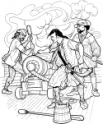Matross
And where, exactly, is the Slough of Despond?
Dear Word Detective: The word “matross” was used extensively in a novel I just read. The context is 18th century naval warfare and the American Revolution. The word is used as a noun describing members of the ship’s crew. Can you tell me the origin and a more precise definition? I do wish authors and publishers would include more glossary and map material in books with historical settings and dialects. — Forrest.
 Oh boy, me too. It drives me nuts to get a third of the way through a book and realize that, apparently overnight, I have lost track of who the characters are, who is married to whom, and which one is the werewolf. Sometimes, in fact, my memory lapses wander out of one book and into another. I have read, for instance, both Tolstoy’s Anna Karenina and Flaubert’s Madame Bovary, but I couldn’t for the life of me tell you in which novel the heroine dives under a train.
Oh boy, me too. It drives me nuts to get a third of the way through a book and realize that, apparently overnight, I have lost track of who the characters are, who is married to whom, and which one is the werewolf. Sometimes, in fact, my memory lapses wander out of one book and into another. I have read, for instance, both Tolstoy’s Anna Karenina and Flaubert’s Madame Bovary, but I couldn’t for the life of me tell you in which novel the heroine dives under a train.
It’s even worse when authors, as in the book you cite, sprinkle arcane terms into the text, apparently assuming that we either know them already or can deduce their meaning from context. Occasionally an author’s work will be both popular and extensive enough to prompt someone else to produce a glossary, such as a book I ran across a few years ago called “A Sea of Words: a Lexicon and Companion for Patrick O’Brian’s Seafaring Tales.” Obviously a labor of love by three diehard O’Brian fans, the book defines and explains hundreds of terms found in O’Brian’s books, from food to weapons to customs of the Royal Navy. The authors even include maps and a whole chapter on “Naval Medicine in the Age of Sail.”
Unfortunately, they forgot (or perhaps O’Brian never uses) the word “matross.” Fortunately, the editors of the Oxford English Dictionary (OED) haven’t, and define “matross” as “An artillery soldier next in rank below a gunner; in the US artillery, a private.” The word, which is now considered a historical term, first appeared in English in the early 17th century, and comes from the Dutch term “matroos,” which designated a sailor of the lowest rank. The entry in Wikipedia for “matross” is apparently drawn directly from the 1911 edition of the Encyclopedia Britannica (now in the public domain), and can be assumed to be accurate. Britannica explains “matross” further: “Matross was a soldier of artillery, who ranked next below a gunner. The duty of a matross was to assist the gunners in loading, firing and sponging the guns. They were provided with firelocks, and marched with the store-wagons, acting as guards. In the American army a matross ranked as a private of artillery.” A “firelock,” incidentally, is what we would call today a “flintlock” musket, a type of rifle that did not depend on a constantly burning “match” (which would have been a very bad idea near barrels of powder).

Anonymous:
August 30th, 2021 at 2:45 am
or we can look them up! I love learning a new word. (O’Brian never uses matross.)